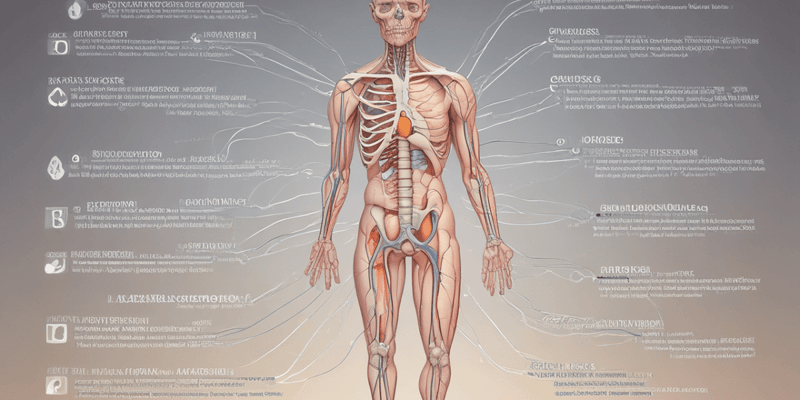Questions and Answers
Which type of nerve injury is characterized by a complete or partial failure to propagate an action potential along the nerve?
Neurapraxia
What is the main difference between neurapraxia and axonotmesis?
The disruption of the axon and myelin sheath
In neurapraxia, what allows for a potential recovery of motor function?
Re-myelination of the distal segment
Which part of the nerve remains intact in axonotmesis injuries?
Signup and view all the answers
What is the characteristic feature of neurapraxia in terms of time to recovery?
Signup and view all the answers
Which type of nerve injury is usually caused by severe compression or crush?
Signup and view all the answers
What is the most common ulnar nerve impingement location?
Signup and view all the answers
Which nerve lesion is characterized by a hand in ulnar claw position?
Signup and view all the answers
What symptom is associated with femoral nerve lesion?
Signup and view all the answers
Which nerve lesion is characterized by a high-stepping walk and foot drop?
Signup and view all the answers
What is a common cause of obturator nerve lesion?
Signup and view all the answers
Which syndrome is associated with diffuse heel pain that worsens throughout the day?
Signup and view all the answers
What is another name for a brachial plexus lesion causing 'porters tip'?
Signup and view all the answers
What muscles are affected in a lesion involving the brachial plexus?
Signup and view all the answers
Which nerve is usually involved in Klumpke’s palsy?
Signup and view all the answers
What is a characteristic symptom of Klumpke’s palsy?
Signup and view all the answers
What is a common cause of Klumpke Palsy?
Signup and view all the answers
Which symptom is often associated with Klumpke's palsy due to traction of sympathetic fibers?
Signup and view all the answers
Study Notes
Nerve Injuries
- Neurapraxia: Characterized by a complete or partial failure to propagate an action potential along the nerve.
- Difference between neurapraxia and axonotmesis: Neurapraxia is a temporary and reversible injury, whereas axonotmesis is a more severe injury with axonal disruption.
Neurapraxia
- Potential recovery of motor function: Possible due to intact axons.
- Characteristic feature: Recovery usually occurs within weeks to months.
Axonotmesis
- Intact part of the nerve: Endoneurium, which is the innermost layer of the nerve.
Ulnar Nerve
- Common impingement location: Cubital tunnel.
- Characteristics of ulnar nerve lesion: Hand in ulnar claw position.
Femoral Nerve
- Symptom associated with femoral nerve lesion: Knee extension weakness.
Peroneal Nerve
- Characteristic feature: High-stepping walk and foot drop.
Obturator Nerve
- Common cause of obturator nerve lesion: Pelvic fracture or osteitis pubis.
Tarsal Tunnel Syndrome
- Characteristic symptom: Diffuse heel pain that worsens throughout the day.
Brachial Plexus Lesion
- Also known as: 'Porter's tip' or 'Erb's palsy'.
- Affected muscles: Deltoid, biceps, and brachialis muscles.
Klumpke's Palsy
- Involved nerve: Lower brachial plexus (C8-T1).
- Characteristic symptom: Claw-like hand deformity.
- Common cause: Trauma during birth.
- Symptom associated with traction of sympathetic fibers: Horner's syndrome.
Studying That Suits You
Use AI to generate personalized quizzes and flashcards to suit your learning preferences.
Description
Explore the structure and classification of peripheral nerve injuries including cranial and spinal nerves, efferent and afferent axons, myelinated and nonmyelinated fibers, and different types of nerve injuries. Learn about the components of peripheral nerves such as epineurium, perineurium, and endoneurium.




